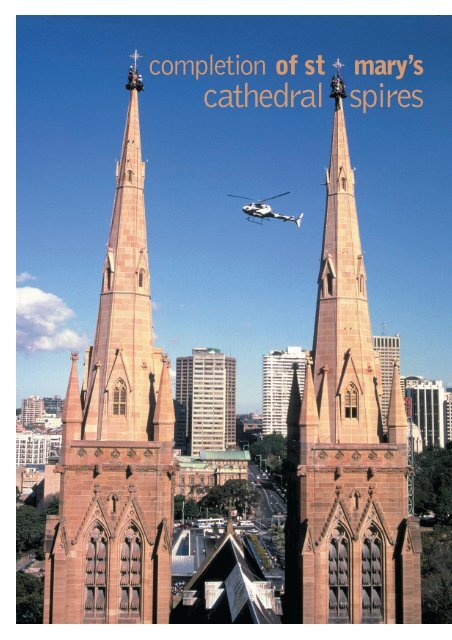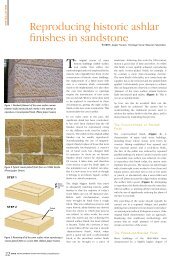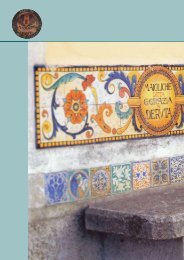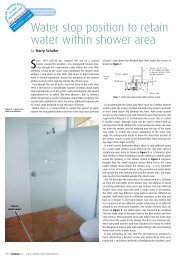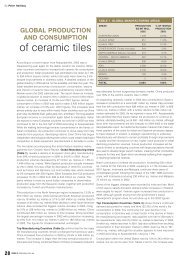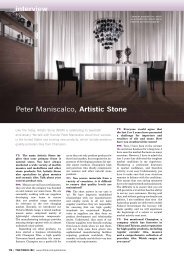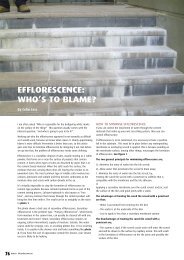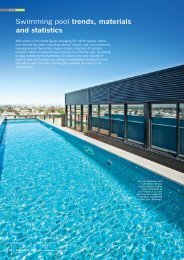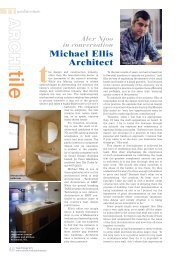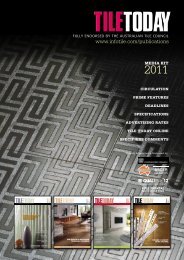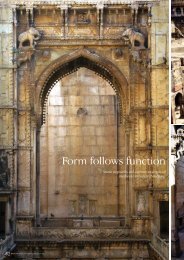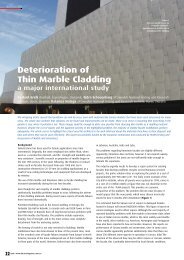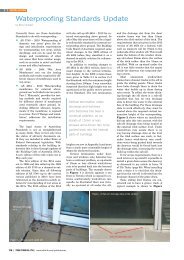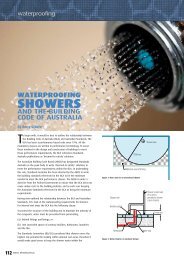Create successful ePaper yourself
Turn your PDF publications into a flip-book with our unique Google optimized e-Paper software.
completionof stmary’scathedral spires
introductionIn August 1998 Gosford Quarries received notification of their successfultender bid for the supply and installation of ‘Wondabyne’ sandstone tocomplete construction of the spires of <strong>St</strong> Mary’s Cathedral.The name of Gosford Quarries is synonymous with sandstone in Sydney,and the company is renowned for the restoration and conservation ofmany of Australia’s significant 19th century historic buildings. Theopportunity to be involved with the building of the spires at the southerntowers of <strong>St</strong> Mary’s Cathedral, faithful to the original Wardell design, wasthe ‘opportunity of a lifetime’ for the company.Prior to the tender on the spires in September 1997, Gosford Quarrieshad commenced work for the Cathedral on a separate contract for theconservation and repair of the Western Transept stonework as the headcontractor.The company’s formal introduction to the spires project was at the briefingfor pre-selection of contractors held in October 1997. During hisintroduction Monsignor Tony Doherty outlined budget figures, basic stonerequirements, requirements for seismic strengthening and importantly,target completion dates for the Cathedral to be crowned with spires bythe time the Olympic marathon was to pass by in September 2000.At this time the NSW DPWS offered estimates of the volume of stoneworkbased on their computer modelling at 80m 3 net per spire.The calculation by Gosford Quarries of volumes based on net rectangularcubic prisms required to complete the stonework was 350m 3 (in excessof 800 tonnes). This would be cut from an estimated 600m 3 of grossquarry block from the Wondabyne Quarry.wondabyne sandstoneWondabyne is near Woy Woy on the Central Coast of New South Walesand produces ‘dimension’ sandstone regarded for its excellent carvingqualities and durability.Many famous buildings in Australia have this unique building sandstoneadorning their façade. Some examples include: Commonwealth Bank‘Money Box Bank’ <strong>St</strong>age 2, Pitt <strong>St</strong>reet, Sydney; Grace Bros. Building,George & Market <strong>St</strong>reets, Sydney; David Jones Buildings, Elizabeth<strong>St</strong>reet and Market <strong>St</strong>reet stores, Sydney; Australian War Memorial andAdmin Buildings, Canberra; Spires on <strong>St</strong> Patrick’s Cathedral, MelbourneWondabyne sandstone is quarried grey in colour and oxidizes over manydecades to a warm light brown colour. For its application as a restorationstone, it can be colour ‘toned’ to better match the oxidized colours oftypical Sydney historic buildings. An example of this technique is the manyreplacement stones used on the east façade restoration of the SydneyTown Hall in 1991. This technique was also used on the <strong>St</strong> Mary’s spires.the tenderDuring the tender for the spires, Gosford Quarries had considerableconsultation with the selected group of six contractors chosen by theCathedral to bid for the project. It was necessary for all tenderers to bebriefed about all the complexities of fabrication, delivery and installationof 800 tonnes of fully worked sandstone so that the issues of handlingand delivery at a working building site of 30 to 60 metres above the groundcould be fully appreciated.The tender for the sandstone was openly bid with companies fromQueensland and Victoria competing for this significant masonry project.The NSW DPWS stoneyard also tendered for the project. Each contractordiscussed with Gosford Quarries their preferred method of cranage andhoisting for the sandstone units with conventional tower cranes, steelframes supporting gantries and mobile cranes being some of the options.The project specification required approximately 1,272 individually craftedsandstone pieces some weighing 2,000 kg. each. As the specificationprohibited damage to any stone from the time they were lifted onto GosfordQuarries delivery trucks, until final placement into their bed of mortar bytraditional ‘lewis pin’, each stone would require individual and carefulhandling.the successful contractorThe tender bid from Waller Construction won the head contract for thebuilding of the spires. Essentially they were to provide the supportingstructures for access and hoisting systems for the masonry sub-contractand to install the steel sub-frame required for seismic stability of thestonework. The Waller’s system proposed the use of a ‘crane beam’located above each spire supported by the seismic sub-frame and thehoisting of stones to a timber work platform at the base of each spire byan ‘Alimak’ materials hoist.Although Waller’s proposed construction methods were not conventional,their enthusiasm and thorough preparation was a winner with the CathedralWorks Committee.It was essential for the wellbeing of the project that a harmoniousrelationship between Waller Constructions and Gosford Quarries developed.To this end and prior to the commencement of quarrying, a meetingwas convened by Gosford Quarries with Waller Constructions to lay thefoundation for the contractual relationship between the parties.visit to wondabyne quarryOn 29th March 1999 an inspection was held at the Wondabyne Quarry.Access to this historic quarry is by rail or by boat only. Representativesfrom the <strong>St</strong> Mary’s Cathedral Works Committee - Michael Fox Architects;the Board of Directors of Gosford Quarries and Waller Constructionsattended the quarry and walked upon the prepared beds of sandstonethat were destined to be extracted and then carved for the spires stonework.the contract worksThe first stones to the base of the spires were delivered to the buildingsite at the Cathedral on the 11th May 1999 and almost daily deliveriesproceeded from this time.As the main work platform was some 30 metres from the ground andbuilding activity continuous whilst the normal day to day operations ofthe Cathedral were maintained, it was truly a credit to all concernedthat the project was completed without incident.Gosford Quarries ‘master mason’ in charge of all aspects of the installationwas Mario Rago and without doubt the project was the pinnacle of hislifetime’s work as a marble and sandstone mason.During the course of the work a great benefit to the project, was theuse of laser lights to align the horizontal levels and check the vertical‘twisting’ of the masonry as it was erected. We believe the two spiresare within 4 mm of the theoretical dimension on the contract documents,an amazing success story from the fusion of old and new technologies.Remarkably and perhaps because of heavenly intervention, for the durationof the site activity, the wind and rain were recorded at very low levelsand the ‘downtime’ was kept to a minimum despite the nature of theextreme exposure of the work platforms. The last stones and crowningfinials to the spires were delivered to site on 2nd June and put in positionand fixed on 6th June 2000.the blessing of the spiresA service and blessing conducted by His Eminence Cardinal Clancywas held at <strong>St</strong> Mary’s Cathedral on the 18th August to celebrate thecompletion of the Cathedral to the original design with the completionof the two crowning spires.For the personnel at Gosford Quarries the successful completion of thishistoric project has been a significant and satisfying achievement. issue #3 www.discoveringstone.com15<strong>St</strong> <strong>Mary's</strong> 219/3/03, 3:53:58 PM


